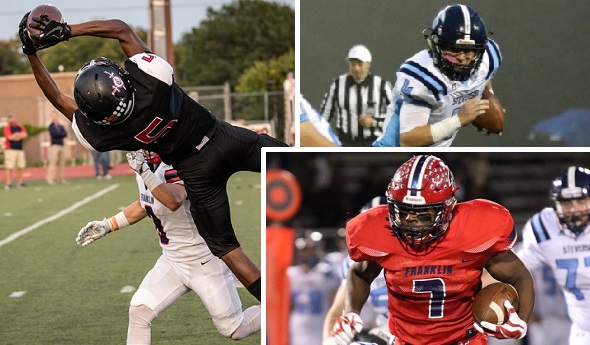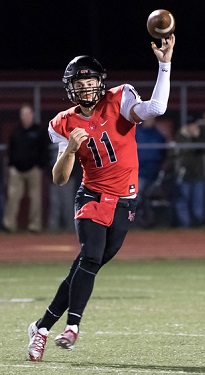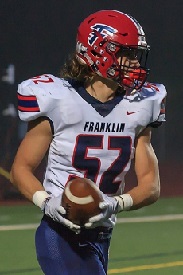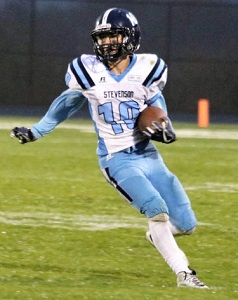
Playoffs Packed with Livonia Power
By
Tom Markowski
Special for Second Half
October 25, 2017
LIVONIA – Let the good times roll.
 Football fans in Livonia have been blessed recently with the success of Livonia Public Schools’ football programs, and this season is no exception.
Football fans in Livonia have been blessed recently with the success of Livonia Public Schools’ football programs, and this season is no exception.
Churchill, Franklin and Stevenson all qualified for the MHSAA playoffs, and glancing at the pairings all have a reasonable shot at winning their Pre-District games and perhaps a District title as well.
Churchill and Franklin are both 7-2 and open Division 2 play as visitors, Churchill at Pinckney (8-1) and Franklin at Walled Lake Western (8-1). Stevenson will compete in Division 1 and, even though the Spartans are 5-4, will play host to Detroit Catholic Central (5-4). All three games are Friday at 7 p.m.
All three are members of the Kensington Lakes Activities Association. Franklin has made the playoffs three consecutive seasons and reached a Division 2 Semifinal in 2015. Churchill has qualified for the playoffs five of the last seven seasons and Stevenson, the most consistent program of the three, is in for the fifth time in the last six seasons. (Livonia Clarenceville, another public school in Livonia, is not part of the Livonia Public School system and did not make the playoffs this fall.)
The three head coaches agree that the source of this recent success is a thriving little league program, the Livonia Junior Athletic League. Four teams compete in the league – the Blue Jays, Eagles, Falcons and Orioles – and players range in age from 6 to 13. Those 6 and 7-year-olds compete in flag football.
The LJAL is the lifeline to the high schools because Livonia Public Schools does not sponsor middle school or junior high football.
“We’ve always had a strong little league program,” Franklin coach Chris Kelbert said. “With the little league program, our feeder program, we’ve worked hard to develop a system for them to do what we do.”
 The Livonia schools haven’t always been so successful. Franklin, for example, won the first Class A title in 1975, then went 30 years before making its next playoff appearance. Stevenson made the playoffs just once in the first 19 seasons of the MHSAA tournament. But since 1993, the Spartans have qualified 16 times highlighted by a Division 1 championship game appearance in 2007 and a Semifinal appearance the following season.
The Livonia schools haven’t always been so successful. Franklin, for example, won the first Class A title in 1975, then went 30 years before making its next playoff appearance. Stevenson made the playoffs just once in the first 19 seasons of the MHSAA tournament. But since 1993, the Spartans have qualified 16 times highlighted by a Division 1 championship game appearance in 2007 and a Semifinal appearance the following season.
Then there’s Churchill. The Chargers made the playoffs in 1979, then seemingly disappeared. Not only did they not make the playoffs again until 2004, the Chargers had one of the poorest runs in terms of victories in state history. From 1990-96 they won one game. At one point Churchill lost 34 consecutive. Following those rugged years the Chargers finished 2-7 five straight season (1997-2001).
Times have changed. John Filiatraut, now the head coach at Dearborn Divine Child, helped guide the Chargers out of those rough times as they won the school’s first District title in 2004 and finished 8-4. Except for a 1-8 season in 2005, Churchill has remained competitive since that bounce-back season.
Bill DiFillipo was an assistant under Filiatraut and is in his fifth season as Churchill’s head coach. He said talent in his program keeps improving and he credits the coaches, on his team and within the LJAL, for that progress. He also said the healthy rivalry that exists between the three schools has sparked enthusiasm and an increase in competitiveness.
“This is Churchill’s best run,” he said. “You have to have good feeder teams. We’ve done a good job of developing kids. Our senior class was 0-9 as freshmen, and they were 2-7 on the JV. Over at Franklin, Chris has done a good job. When Randy (Micallef) took over, Stevenson was down. Randy and his staff have done a good job of getting them back.”
Stevenson won just five games combined in 2010 and 2011. The Spartans made the playoffs in 2012 and missed the playoffs the following season, but then rattled off three straight appearances and will make it four straight this weekend.
The three programs annually play for a city championship. Stevenson has won the last two defeating Churchill and Franklin in each of the last two seasons.
Franklin’s only losses this fall were to Churchill and Stevenson, and the Patriots have won five straight since the second of those defeats.
 Kelbert and his staff have done a remarkable job this season. Running back Isaac Moore was a part-time starter last season, and none of the other 10 starters on offense had started even one game. Franklin returned three starters on defense.
Kelbert and his staff have done a remarkable job this season. Running back Isaac Moore was a part-time starter last season, and none of the other 10 starters on offense had started even one game. Franklin returned three starters on defense.
“We have a young offensive line,” Kelbert said. “We have two seniors there, and neither one played offense line before. But we’re clicking now. It’s been frustrating at times. We knew we had some good players coming back. After the Howell game (a 21-0 Franklin victory in Week 5), we saw some improvement. Our defense has been lights out all season. We adopted a new philosophy on defense. We wanted to be more athletic and have more speed. When Romeo won (the 2016 Division 1) title, they won it with small linemen who couldn’t be blocked. We figured we could use that philosophy. The game has changed dramatically in the 19 years I’ve coached in high school.”
Kelbert faced a different test this season. He’s starting his son, Jacob, at quarterback, and he’s just a sophomore. Jacob Kelbert played on the freshmen team last season after going through Livonia’s little league program.
“It has its challenges,” Kelbert said of coaching the eldest of his three sons. “I forget he’s young sometimes. I expect him to play like a senior.”
DiFillipo also has a first-year starter at quarterback, but at least this one was on varsity last season as a back-up. Junior Drew Alsobrooks has played well this season, and he’s benefitted from an experienced offensive line. Four seniors start on the offensive line and the lone junior, Ethan Gyurnek, started last season as a sophomore.
DiFillipo adds that it’s been a team effort.
“Our defense has played the best in the 10 years that I’ve been here,” he said. “We’re giving up 14 points a game.
 “Franklin and us have had the best two defenses in our division (KLAA Gold). Grand Blanc has the best offense, and we held them to nine points. Franklin shut them out.”
“Franklin and us have had the best two defenses in our division (KLAA Gold). Grand Blanc has the best offense, and we held them to nine points. Franklin shut them out.”
It’s been a different season for Stevenson. The Spartans started 4-0, then lost three straight. They beat Salem, 31-10, in Week 8 before losing to Franklin, 35-21, in a KLAA crossover.
Micallef said he’s noticed an improvement in the level of skilled athletes to come through the three programs. Specifically in his program, players like quarterback Parker Graham, all-purpose athlete George Ferguson and two-way back Devin Dunn all have had experiences in other sports as well that have contributed to their competitive nature.
“The coaches have become progressively better across the board,” Micallef said. “And some of the kids who might have gone to private schools now are staying put. Catholic Central moving from Redford to Novi has had a hand in keeping some of the Livonia kids here.
“We have some really good athletes this season. Parker was a running back last year, and we played him in the secondary, too. But with him moving to quarterback, I’ve kept him off the defense. But I had him at linebacker last week, and he had like seven or eight tackles. Both him and Ferguson play basketball and baseball, and Devin is a multi-sport athlete, too. In crunch times, these kids have played in so many big baseball games or big basketball games that they’re not afraid to make the big play. They embrace that.”
 Tom Markowski is a columnist and directs website coverage for the State Champs! Sports Network. He previously covered primarily high school sports for the The Detroit News from 1984-2014, focusing on the Detroit area and contributing to statewide coverage of football and basketball. Contact him at [email protected] with story ideas for Oakland, Macomb and Wayne counties.
Tom Markowski is a columnist and directs website coverage for the State Champs! Sports Network. He previously covered primarily high school sports for the The Detroit News from 1984-2014, focusing on the Detroit area and contributing to statewide coverage of football and basketball. Contact him at [email protected] with story ideas for Oakland, Macomb and Wayne counties.
PHOTOS: (Top) Clockwise from left, Churchill’s Martell Dooley, Stevenson’s Parker Graham and Franklin’s Isaac Moore are among standouts for the Livonia Public Schools’ three playoff-bound varsity teams. (Middle top) Churchill junior quarterback Drew Alsobrooks has stepped in well as the starter this fall. (Middle below) Senior linebacker Jacob Mass helps key a more athletic Franklin defense this season. (Below) Senior George Ferguson is one of the multi-sport athletes making major contributions to Stevenson’s success. (Photos courtesy of the Churchill, Stevenson and Franklin football programs.)

NFHS Voice: Campaign Touts Benefits of High School Football
By
Karissa Niehoff
NFHS Executive Director
May 21, 2021
A full return to high school sports and performing arts programs – that’s the hope for this fall in schools across the country.
After a year of unprecedented challenges in keeping these programs going due to the pandemic, which included 11 states that conducted their primary football season this spring, there is great optimism as we look to a new school year.
Even in those states that were able to conduct activities last fall, attendance restrictions kept many fans out of stadiums and watching games online. However, with vaccine eligibility now at 12 years of age and older and with vaccinations continuing during the next three months, the likelihood of routines and traditions returning this fall grows stronger each day.
And there is no tradition more anticipated than the full-scale return of high school football. While there were 34 states there were fortunate enough to conduct football at some level last fall, the routines were anything but normal.
This fall, however, we anticipate a return to the energy and excitement of the 2019 season when 1,003,524 boys participated in 11-player football. That total marked a decline of only 2,489 from the previous year and was a good sign of a renewed confidence on the part of parents and student-athletes that concerns about the risk of injury were being addressed.
While boys participation in 11-player football has exceeded one million participants every year since 1999 and is overwhelmingly the most popular boys sport, there have been concerns about declines in past years.
Last fall, the NFHS and the National Football League announced a partnership to promote the growth, understanding and support for football at the high school level. The NFHS and NFL have been studying participation trends, developing educational tools and striving to restore confidence in students and parents that the sport is, in fact, more focused on risk minimization than ever before.
As a result, the springboard to the return of high school football next fall begins this week with the launch of the #ThisIsHSFootball campaign. Through this effort over the next few months, the NFHS will be reaching out to coaches, students, parents, officials, athletic directors and others with research information, participation trends and data on various risk mitigation efforts that, we believe, continues to make high school football safer than it has ever been.
As a part of this effort, the NFHS produced a video entitled “This is High School Football” designed to detail the benefits of participation in high school football.
As the video states, more so than at any other level of play, parents should feel good about their kids playing high school football.
>Here are some of the many educational and medical safeguards put in place the past 12 years to offer parents a comfort level about the safety standards that are a part of high school football.
► Concussion research and education. All NFHS high school playing rules require a student who is exhibiting signs of a concussion to be removed from the game and not allowed to return until the student has been cleared by a medical professional. Thanks to education and training on the part of students, coaches, trainers, parents and others, research data has shown positive trends in concussion rates. In a recent five-year period, concussion rates during practices dropped from 5.47 to 4.44 concussions per 10,000 athletic exposures.
► Concussion in Sport Course. This free online education course has been available through the NFHS Learning Center since 2010, and millions of individuals have taken the course for a deeper understanding about concussions.
► Concussion Laws. By 2014, every state had adopted state concussion laws that established mandatory protocols, and every state high school association has adopted policies that limit contact during preseason drills and in practices during the season.
► Football equipment. Manufacturers continue to produce higher quality equipment every year, and high school coaches are doing a much better job at teaching and coaching the rules of the game and making attempts to minimize risk of injury for players.
► Emergency Action Plans. Thanks to the NFHS Foundation, a copy of the “Anyone Can Save a Life” emergency action plan originally developed by the Minnesota State High School League was sent to all state high school associations and their high schools, and all schools have access to an AED to help save lives.
► Playing Rules. Risk minimization is a major focus of every NFHS sports rules committee. In football, helmet-to-helmet hits are not allowed.
High school football has been a significant part of schools, towns and communities across America for almost 100 years. The NFHS is committed to making the sport as safe as possible for the millions of kids who will play the sport in the years to come.
Dr. Karissa L. Niehoff is in her third year as executive director of the National Federation of State High School Associations (NFHS) in Indianapolis, Indiana. She is the first female to head the national leadership organization for high school athletics and performing arts activities and the sixth full-time executive director of the NFHS, which celebrated its 100th year of service during the 2018-19 school year. She previously was executive director of the Connecticut Association of Schools-Connecticut Interscholastic Athletic Conference for seven years.

